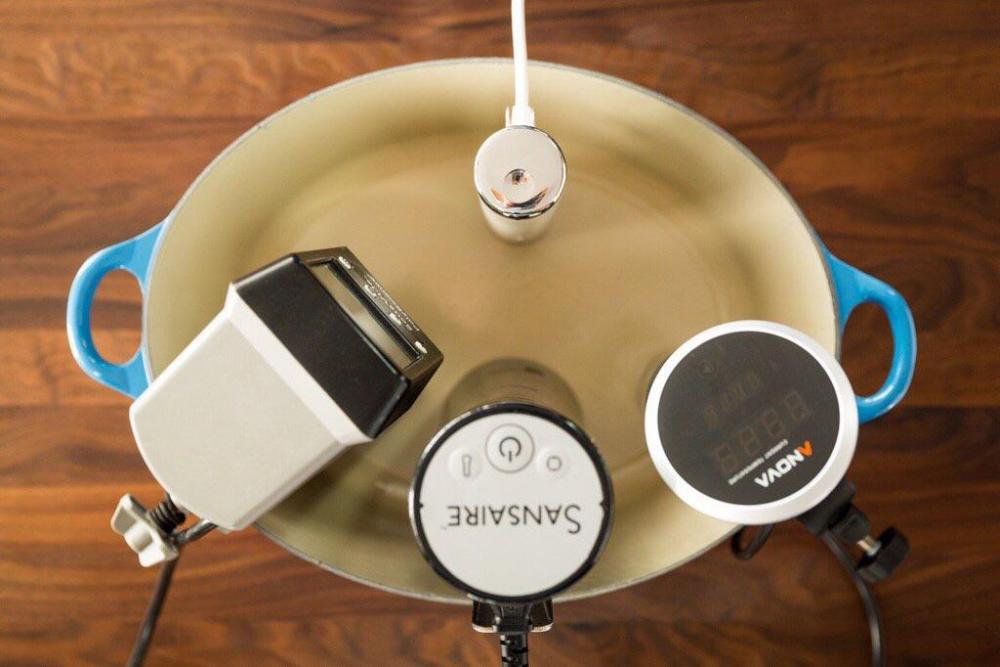-
Posts
1,807 -
Joined
-
Last visited
Content Type
Profiles
Forums
Store
Help Articles
Everything posted by btbyrd
-
Yeah, so... I couldn't resist the Instapot deal. I wish it was the largest version, but whatever... Too good a deal to pass up.
-
Nice! Thanks for the tip Martin!
-
One thing I've been wanting to find is sucralose that isn't bulked with maltodextrin for use in sweetened beverages and cocktails. I know sucralose is very, very sweet by weight, but it would be nice if you could buy a 500ml container of a strong sucralose/water solution and then add it into things drop by drop (or dilute it down further to make a "simple syrup" from it). The maltodextrin in Splenda makes things extra foamy, and I'm not a fan of that.
-
Why do you want it? Is there a special application you think it would be good at? I wouldn't use it for sous vide, and circulators are cheap these days. Given that you already have a food processor, I think you'd probably be much better off getting a ciruclator and a standalone mixer than buying a complex and expensive multitasking platypus.
-
There's no mystery there. Low quality brands taste bad because they're low quality. They're sloppily processed, contain unnecessary ingredients and fillers (yes, water is a filler), and are made to be cheap rather than delicious.
-
The OP complained that canned tuna: 1) Contains soy 2) Contains flakes rather than chunks or slices of loin 3) Tastes dull, smells musty, and is unappetizing. 4) Had a higher tuna to water ratio than they liked. The reason we've been discussing our favorites is that the complaints just listed only apply to low-quality garbage brands of tuna such as those mentioned in the original post. Bumblebee, for instance, packs their tuna in vegetable broth, not water. This is presumably to make it taste better (because they apparently start with fish that don't taste very good... or they screw it up in the processing). The soy in the broth is most likely hydrolyzed soy protein... a source of free glutamic acid. Brands such as this also don't process their fish very carefully and basically grind up the tuna before it hits the can. That's an overstatement, but that's why it appears to be a can of tuna bits, flakes, and scraps rather than something identifiable. Good brands don't look like cat food. They also taste better, and often don't contain any added water at all. In short, if you buy Ortiz or Wild Planet (or another premium brand that others have recommended here), you won't run into problems with soy, texture, flavor, or wateriness.
-
The 6 quart Instapot is on sale at Amazon for $69.99 for Prime Day. I really, really don't need one. I have a rice cooker, pressure cooker, and a circulator. But damn that's tempting.
-
Your new kitchen looks So. Much. Better. than before the remodel. Well done!
-
This is my preferred oil-packed tuna as well. I usually buy it in bulk from Zingerman's every July when they have their annual sale (with lots of tinned fish at good prices) but I just noticed that you can get cases of 12 on Amazon (Prime) for even cheaper than the Zingerman's sale price. For non-oil-packed tuna, my go-to is Wild Planet's wild-caught albacore. I would call it water packed, but there's no water added... the liquid in the can is simply the juices of the tuna which emerge during the canning/heating process. I like their sardines too, but that's a matter for another thread...
-
No luck on this week's Cooking Issues. *sadface*
-
@DiggingDogFarm : Nice find on the Cooking Issues episode... I knew I'd heard it at some point, but it was a double-time last minute blurb at the end of an episode which may or may not have omitted certain details. When I e-mailed, I asked if maybe Hunter would be willing to phone in and give the details, so maybe we'll get the full story on Tuesday. You might be right, but I'm not sure that longer aging at lower temperatures would make a difference. What's doing the work in either case is enzymatic breakdown and the Maillard reaction, both of which are accelerated at high temperatures. If the flavor and texture are the same with the 3-day method as they are in the 30 day method (and I'm not saying that they are, since I haven't tried it) it is likely that the nutritional results are there too. I doubt we'll see studies on this anytime soon...
-
My bad. I had the episode playing in another window and misread the number. I edited my post so that the proper episode is indicated.I was all set to ask about Hunter's recipe on today's episode of CI, but it was a re-run and nobody was in the chatroom by the time I arrived. Next week, maybe? In any event, let me know how you like the RioRand. I've tried three different brands of black garlic... one from Trader Joe's, one from Whole Foods, and the RioRand from Amazon. The RioRand is my favorite by far... giant cloves and no peeling (and no paying for the weight of papery garlic skin). I never had more than one brand in the kitchen at a time, but they all seemed to have the same basic flavor profile. Beautiful dishes! Thanks for sharing.
-
They just mention it, but don't discuss it in depth in that episode.
-
The 3-day black garlic technique was developed by Jonny Hunter and was discussed briefly at the beginning of Episode 231. (EDIT: It's actually Episode 237). They've talked about it a few times, but I'm not sure if they ever fully outlined the technique on the podcast. I know that Hunter presented the technique at a MOFAD event called pHDelicious that was about the impact of pH on cooking. So they may have tweaked the pH during the warming step to accelerate the process. I'll see if I can find out more. What are people's favorite recipes/applications using black garlic? I have a big container of RioRand brand peeled black garlic cloves and am trying to think of new ways to use them. If you're in the market for pre-made black garlic, I highly recommend the RioRand products. The cloves are gigantic, and the fact that there's a pre-peeled option is great (peeling black garlic can be a bit of a chore since it's soft and sticky).
-
Polyscience bought Sous Vide Dash and rebranded it as the Polyscience Sous Vide Toolbox app.
-
If you're looking for ideas about what brands of instant noodles to try, these are some good resources: Lucky Peach's Instant Ramen Power Rankings Serious Eats's Top 10 Instant Noodles From Around the World The Ramen Rater Of the widely-available-in-supermarket-brands, both I and most of my ramen-loving friends prefer Shin Black. But if you're just buying noodles to use in your own broth, any brand will do (though it's worth trying to track down fresh Sun Noodles for that purpose). Sun Noodles also sell fresh noodles with various flavor packets/pouches included, and those are very good.
-
There are multiple clips... a smaller one to work with pots and pans and a wider one to clip onto Cambros and coolers.
-
The Joule works with both iOS and Android devices. There are a lot of features in the app that make it ideal for someone just starting out. Visual doneness is a really cool feature that lets you select a time/temperature combo by looking at videos of meat cooked at that time/temp. It's sort of an evolution of their Egg Calculator. And there will be integration with ChefSteps' SV cooking guides and recipes as well.
-
When I first started out, Polyscience had just come out with the Creative Series, which, at $400, was the cheapest circulator around. That seemed too expensive for a piece of equipment I was basically experimenting with, so I ended up with the DorkFood DSV -- kind of SV controller with a temperature probe that you can plug a rice cooker or crock pot into. After using it twice, I was convinced that I should have spent money on a real circulator. I was sold on the technique of SV, but wanted something that could maintain an even temperature throughout the bath and also handle larger cuts of meat. Fast forward a few months, and I picked up a factory refurbished Polyscience Chef Series. It has been my workhorse for several years... it looks and feels like it belongs in a commercial kitchen (I mean that in a good way). I purchased it before the Anova, Sansaire, Nomiku, and everything else hit the market, though a couple of those had already Kickstarted. While I'm sure those are all nice units, I'm glad that I've been using the Polyscience. I have never had an issue with it. Ever. It's nice to do long cooks worry free. I've heard so many stories about people's circulators turning off in the night or while they're at work... I just don't get it. The only thing that really bothers me about it, apart from how big it is (it's almost too big to use in a stock pot -- a Cambro is a must), is how loud it is. It's not super loud, but I can hear it whirring all throughout my (small) house, and that can be irksome if I'm doing short ribs for three days. Since I've had this circulator, the market has become saturated with inexpensive circulators and SV is now accessible to the masses. That's awesome. But fundamentally, all of these circulators work in the same way, with the same coiled heater and the same basic style of pump. Even though some have integrated wi-fi, all the new designs have been evolutionary rather than revolutionary. But I sincerely think this is about to change when ChefSteps introduces Joule. Everything about it is different, and everything about it is better. It's smaller, lighter, faster, quieter, and more powerful than damn near every other circulator on the market. The hardware is as beautiful as it is innovative. Just look at it! (Photos from Chefsteps.com/joule) And look how huge it makes my Polyscience seem by comparison: From the inside out, it's a game-changer. It used to freak me out that there were no physical controls on the unit apart from the on/off switch. But I -- very slowly -- came to realize that my iPhone can function as a much better display and controller than any other possible alternative. And I always have it on me anyway. Omitting the display means a sleeker design with fewer parts to break. Anyway, it's not out yet so I can't recommend it from personal experience. But I've preordered one, and have the feeling that my Polyscience Chef Series may end up on eBay after Joule arrives. When people ask me what circulator they should get, my reply is now "Pre-order Joule. It's not on the market yet. There are no real-world user reports yet. But trust me. That's what you want." But when Anovas go on sale for $120, it's hard not to buy one. Or two... or three...
-
Sort of off topic, but I love using my chamber vacuum for quick pickles.
-
+1. That was immensely entertaining. Thanks for the link Martin!
-
Bones don't matter with respect to flavor on a roast. As far as heat lamps are concerned, there's no difference in safety between SV beef that's been finished in the oven and conventionally roasted beef. If anything, the SV beef would be marginally safer because it will have been pasteurized during the cook step.
-
You can also pressure cook tendons, dehydrate them, and then deep fry to make tendon "chicharones."
-
I didn't want to; I needed to. I seasoned it aggressively, as per my typical steak protocol, but once it got to the plate it still needed a good deal of seasoning. My theory about all this is that fat coats your palate which impairs your ability to detect salt. And when you have a ribeye that's 50% fat, you really, really, need to up your seasoning. I'm usually not able to find meat like this, even in the Chicago area, but they were running a special on imported Japanese Wagyu at my semi-local (40mins away) Mitsuwa marketplace. It's not an item they normally carry, and I wasn't even aware that it would be available when I visited (I went to buy fresh ramen noodles). But when I saw it in the meat case, I couldn't say no.
-
Yes. This steak required more salt than I've ever put on any other piece of protein in my entire life. On the flip side, I've noticed that grass-fed/finished beef (which is relatively lean) requires less seasoning than conventional grain-finished beef. Thickness of the cut matters too, but it's not the only factor (that Wagyu above was relatively thin and still required boatloads of salt). Tenderloin, for example, is pretty lean regardless of the cow's diet, but I always season generously because I always cut them thick.





